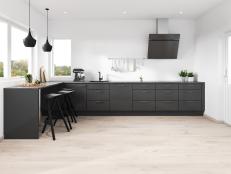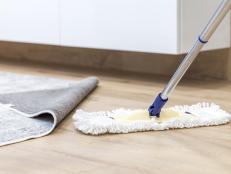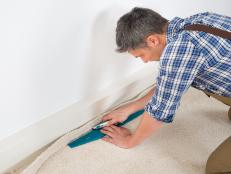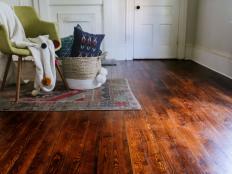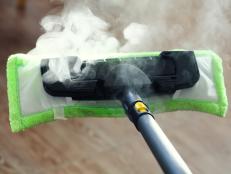Natural and Recycled Flooring Materials
Natural and recycled flooring materials can be as beautiful, comfortable, durable and livable as their more traditional counterparts. And best of all, natural and recycled materials are better for the environment because they're made from clean, renewable sources and reuse materials that otherwise might have been landfilled. Using natural and recycled flooring products results in better indoor air quality because these products have little or no VOC (volatile organic compound) emissions, unlike many traditional types of flooring and their associated binders, adhesives and sealants.
Many green flooring options are available for residential use. Natural products include natural-fiber carpeting, bamboo and cork, and recycled products include carpet tiles, reclaimed wood, terrazzo, and antique brick and stone. Here's a look at each:
Natural-Fiber Carpeting
One category of natural-fiber carpeting is wool-based carpeting. The natural resilience of wool offers durability that exceeds that of most synthetics. It's also naturally water-repellent, a good insulator and highly fire-resistant. A wool-hemp-blend variation offers more mold and mildew resistance, strength, pest resistance and ultraviolet (UV) resistance than wool alone. A potential drawback of wool-based carpeting is that its use is limited to well-ventilated, relatively dry areas of the home. Although wool is water-repellent and wool-hemp somewhat mold- and mildew-resistant, for best performance these types of materials should not be continually wetted without drying, such as might occur in bathrooms.
Another category of natural-fiber carpeting is grass-based carpeting, which includes jute, sea grass, sisal, linen and coir. Grass-based carpetings derive their strength from the weave and are naturally anti-static. They are also affordable, versatile, easy to install and made from rapidly renewable, sustainable resources. Some materials have limitations on where in the home they can be used. For example, jute deteriorates when consistently exposed to water and sunlight, and sisal has a rough texture and absorbs moisture readily. And sea grass has a bit of an aesthetic limitation in that it can't be dyed.
Bamboo
Bamboo flooring is resilient, termite-resistant and stronger than the strongest hardwoods (red oak, cherry, teak and walnut). And unlike hardwoods, bamboo is a rapidly renewable resource — it's harvestable only four to six years after planting. Bamboo is well-suited to dry as well as humid climates and doesn't crack. Installation is also easy, as most brands fit together with tongue-and-groove construction and quick-set glue. And the cost of bamboo flooring is competitive with hardwood flooring.
The biggest drawback of bamboo flooring is that some poor-quality products are available. To ensure quality, verify that the raw material comes from plantation-managed timber rather than from the wild, and be sure that low-VOC adhesives are used in manufacture and that the bamboo is dried to a low moisture content to withstand dry and humid conditions. If a finish is pre-applied, be sure it's high-quality and scratch-resistant. Another potential drawback is that some bamboo floorings can't be used over in-floor radiant heat systems.
Cork Parquet or Planks
A natural and renewable resource, cork is harvested from the bark of the cork oak tree, which is native to the Mediterranean coast. A tree must be at least 25 years old before its bark can be harvested; after that, cork can be harvested every eight to 14 years for the life of the tree. Cork has a unique set of properties not found in any other naturally existing material: It's lightweight, mold- and mildew-resistant, fire-resistant, termite-resistant, antimicrobial, impermeable to gas and liquid, and soft and buoyant. Cork also is resilient, so recovery from marks caused by furniture will leave minimal residual indentation. Because it "gives" when compressed, a cork floor provides a comfortable cushion underfoot. Finally, cork is a natural thermal and acoustic insulator, which means rooms with cork flooring are naturally warm and quiet.
A potential drawback of cork flooring is that some types are not recommended for use below grade or over in-floor radiant heat systems.
Recycled Carpet Tiles
Recycled carpet tiles actually are new carpeting tiles manufactured by grinding up used vinyl and nylon carpeting. In some brands, the actual loop itself as well as the backing contain recycled material. This saves materials that would otherwise be landfilled. Some manufacturers offer great design flexibility by allowing customers to mix and match tiles to create custom wall-to-wall carpeting and area rugs. The modular nature of the product also results in less waste from cutting to size, and worn spots can be replaced without replacing the entire carpet. At the end of its usable life, carpet tiles can be recycled and used for new carpeting.
Check manufacturer specifications carefully to ensure that the carpeting is made with low-VOC adhesives and backing.
Reclaimed and Salvaged Wood
These unique wood floorings are composed of re-milled lumber from deconstructed buildings and newly milled lumber from standing dead trees that have been salvaged from waterways and urban areas. Reclaimed and salvaged woods help to reuse materials that would have been otherwise incinerated, which contributes to greenhouse gases. Reclaimed and salvaged wood flooring can be a striking addition to a home. Nail holes, streaking and other character marks are typical, giving the wood a rustic look.
Avoid any reclaimed wood that was treated for its previous application. For example, wood that has been painted, glued or coated may contain lead or arsenic-based wood preservatives. Until 2003, arsenic was widely used as a preservative in pressure-treated lumber, and until 1978, lead was widely used as a pigment and drying agent in oil-based paint. Scientific Certification Systems (SCS) has published clear definitions for reclaimed and salvaged wood.
Terrazzo Tiles or Planks
Terrazzo consists of small colored chips of glass, stone, masonry, concrete or tile bound together by an adhesive matrix that's either concrete or epoxy-based. The chips can be virgin materials or, preferably, recycled materials. Both the chips and the matrix come in a wide range of materials and colors that can be used to create a multitude of aesthetic effects. Terrazzo flooring is also durable and lasts 40 years or more, which means low maintenance and replacement costs over time. Terrazzo typically won't chip, stain, burn or support bacterial growth. Terrazzo floors are also easy to maintain, requiring only a damp mop except in high-traffic areas. After their useful life, they can be recycled to create new floors.
A drawback of some terrazzo products that use an epoxy-based matrix is that epoxies frequently contain phenols and xylenes, two VOCs that should be avoided. Epoxy-based terrazzo is available in pre-finished tiles, which most people tolerate well, but poured-in-place epoxy-based terrazzo poses VOC-exposure issues for installers and homeowners before curing.
Antique Brick and Stone
Antique bricks and cobblestones are available to enliven floors, walls, walkways, courtyards and more. The materials are reclaimed from buildings and streets throughout the United States. Antique bricks typically were made from local natural materials, and cobblestones were cut from local stone. Using these re-purposed materials adds history, beauty and one-of-a-kind character to a home. In addition, using them saves the resources that would have been needed to manufacture new materials.
A potential drawback of using antique brick or stone is the cost and resources required to transport them from their original site.






